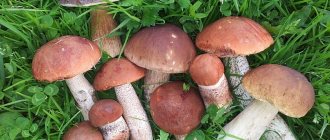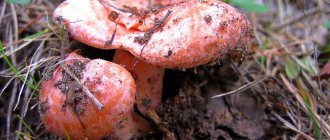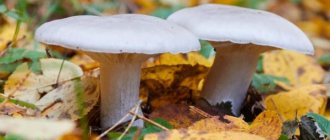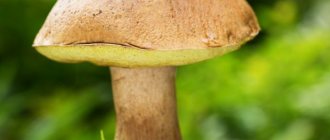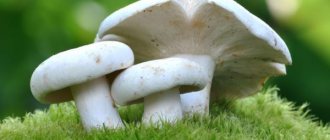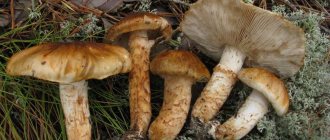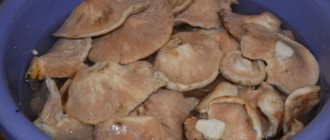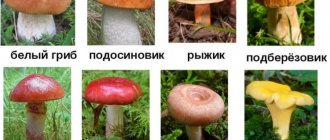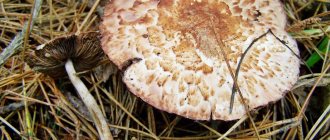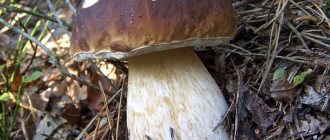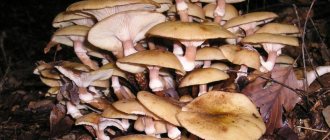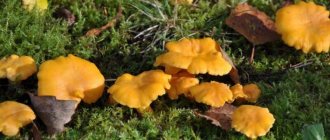The porcini mushroom is one of the most valuable and useful in its properties representatives of the forest flora and belongs to the genus of boletus mushrooms. You can meet representatives of this family almost everywhere, with the exception of some regions of the globe, Australia and Antarctica. The mass collection of this product occurs mainly in the second half of June and continues until September, and this depends on the place of growth of a particular species. Boletus mushrooms reach maturity within a week, which makes them different from other types of mushrooms. They grow in large families or colonies, so when you encounter one mushroom, you can hope for a big, quiet hunt.
general information
The origin of its name, boletus, like many of its fellow boletuses (for example, boletus and boletus), is due to its habitat. That is why this mushroom is called so because it can be found most often and in large quantities in pine forests.
Boletuses are edible mushrooms and are awarded the first and second degrees of nutritional value. In addition, with their pleasant taste, they have captivated mushroom pickers since ancient times, and the many ways to prepare them were appreciated by skillful housewives.
— Advertising —
Boletus (or boletus) belongs to the class Agaricomycetes, genus Boletaceae and family Boletaceae.
Useful and healing properties
Since mushrooms contain a large amount of valuable vitamins, organic acids and chemical elements, they have numerous beneficial properties and are widely used in folk and official medicine. Preparations based on porcini mushrooms provide the following effects on the body:
- Strengthen joints and prevent osteoporosis.
- Fighting anemia.
- Supports the heart muscle.
- Increases hemoglobin content in the blood.
- Stimulates the strengthening of the protective functions of the immune system.
- Prevents the accumulation of cholesterol plaques in blood vessels.
Mushrooms contain components that have powerful antibiotic properties and eliminate E. coli or various forms of tuberculosis. The composition of the product is enriched with riboflavin, which is of particular value in the field of cosmetology.
Adherents of traditional medicine used boletus lotions to treat frostbitten parts of the body. With the help of tinctures you can fight insomnia and nervous excitability.
Characteristic
Mushroom dimensions
Fans of “quiet hunting” are very happy when they see boletus in a clearing - after all, given that they often grow in groups and are quite large in size among other edible mushrooms, you can very quickly collect a full basket of excellent gifts of nature. Having in their arsenal such positive qualities as fairly large parameters, at a more mature age they can generally reach impressive sizes and gain up to 1 kg of weight.
hat
— Advertising —
The color of the cap varies from white and light yellow to dark brown, almost black - depending on the species of boletus, of which there are a huge number in nature. Regarding the size of the cap, it also has a wide range - on average, from 5 to 25 cm in diameter. Boletus belongs to the cap tubular mushrooms and has light white, yellow and even reddish pores, and the spore powder is characterized by all shades of brown. The shape of the cap is round, and can have either a cushion-shaped or flat appearance. In terms of tactile sensations, it is dry, velvety, and absolutely smooth to the touch.
Pulp
The boletus pulp is white or light yellow, lemon-colored. In most species the cut turns blue, in some the color remains unchanged or turns red.
Leg
— Advertising —
The size of the mushroom stem is also directly dependent on the subspecies - but, basically, the average is 3-18 cm. White, yellowish, brown and reddish - it is always quite massive and has a specific thickening at the base or middle part of the mushroom stem. Sometimes it feels even and smooth to the touch, but, in most cases, the leg has a mesh or fibrous surface.
Other types of porcini mushrooms
Sometimes “ceps” are other types of mushrooms that have white or very light colored mushroom bodies: white boletus, marsh boletus, linden, etc.
There is also a mushroom belonging to this species - the so-called semi-white mushroom. In terms of nutritional quality, this mushroom is lower than the white one, and is less common. It looks like this: on a relatively thin stalk about 10 cm high there is a velvety brown cap with a diameter of about 15 cm. The flesh is dense yellowish. Tubular layer: in a young fungus it is bright yellow, in an old one it is dirty yellow.
False double
The boletus has a very similar counterpart - the gall mushroom. This false white mushroom has a bitter taste. It is enough to lick the bottom of the cap of the gall mushroom to make sure of this. It is very similar to white, with a pink or dirty pink tint to the lower part of the cap. At the break, the flesh also turns pink, while the noble white flesh remains white.
Where do boletus grow?
Boletuses are one of the most common mushrooms in the world. They can be found all over the globe, except Australia and Antarctica, because their main condition is a temperate climate zone.
Boletuses most often live in coniferous forests (after all, this is where their name comes from), but it is very likely to find them in mixed and deciduous forests.
You should look for boletus mushrooms, first of all, under spruce and pine. These mushrooms also love to settle under chestnut, beech, hornbeam and oak trees. If you're lucky, you can find them next to birch trees, as well as near juniper thickets. Boletus mushrooms grow mainly in groups, but individual specimens are also found.
The mushroom very rarely lives in the tundra and forest-tundra, but in the northern taiga it is possible to collect a large number of excellent boletus mushrooms. And if in the forest-steppe these tasty mushrooms are found less and less often by mushroom pickers, then in the steppe they are no longer available at all. Also, the fertility of boletus mushrooms is greatly reduced when moving from lowland forests to mountainous areas.
Application in medicine
Porcini mushrooms began to be used in medicine back in the 17th century. Their pulp was used to treat frostbite and prevent skin cancer.
Today, not only doctors and traditional healers, but also simple collectors know about the beneficial properties of the mushroom.
Widespread use in medicine is due to its powerful anti-inflammatory, antitumor, immunostimulating and restorative properties.
They eliminate the symptoms of coronary heart disease, prevent thrombosis, strengthen the immune system and help the body cope with infectious diseases, injuries or poisoning.
In medicine there are a large number of medicines based on porcini mushroom. Among them:
- Infusions.
- Decoctions.
- Lotions.
- Alcohol tinctures.
When do boletus appear?
The mycelium of the fungus begins to grow from early spring until late autumn.
The boletus season is considered to be the period from the beginning of summer (in June) to the beginning of autumn (mid-September). At the same time, it is better to go picking mushrooms after the rain.
Since air temperature and humidity play a huge role in the appearance of a sufficient number of these tasty gifts of nature, the greatest likelihood is to meet them on small sunny lawns, on the edges and abandoned paths. Since boletus mushrooms react negatively to high temperatures and lack of rain, you should not hope for their high yields in dry summers.
Edibility
Boletuses belong to the category of edible mushrooms, they have many beneficial properties and good taste. However, there are more than 300 species of boletus, including both edible and inedible and toxic mushrooms, which will be discussed below.
It must be remembered that even edible boletus mushrooms cannot be consumed for food purposes if they are all eaten by worms. Therefore, mushroom pickers should carefully examine each mushroom before adding it to their basket. If the affected area is small, you can carefully cut it off with a knife. Well, if there is a large number of spoiled places in the stem and cap of the mushroom, it should be thrown away. Also, when choosing places for “quiet hunting”, you should avoid polluted areas along highways, railways and environmentally unfavorable areas, because mushrooms are capable of absorbing many substances from the soil and air, both good and dangerous (poisons, toxins, etc.).
Boletuses are very rich in vitamins, microelements, amino acids and even contain antioxidants that help strengthen the immune system and fight cancer. That is why they are in the category of the most useful mushrooms and in their composition are equal to fruits, vegetables and meat. But, alas, with all their positive qualities, boletus mushrooms are quite heavy food for the gastrointestinal tract - because of this, adults should not consume them in large quantities, and children under 12-14 years old should generally refrain from mushrooms in any form.
Pre-treatment of boletus mushrooms consists of thoroughly washing them, as well as removing adhering dirt, leaves and soil. Then you need to soak the mushrooms in salty cold water for 20-30 minutes, and then rinse them again. As for cooking methods, boletus mushrooms can be cooked fresh (boiled, fried or stewed), as well as dried, pickled, canned and frozen - in any of these options you get a tasty, aromatic and healthy dish.
Harm and contraindications
In general, boletus mushrooms have no contraindications or harm, but there are some rules that must be followed.
- Mushrooms should not be given to children under 3 years of age, as they do not have the enzyme that can digest the mushroom.
- If you have problems with the kidneys and liver, then you should use mushrooms with caution.
- Mushrooms are very heavy food, so you shouldn’t overeat them, or eat them at night.
Types (forms) of boletus
In nature, there are more than three hundred species of boletus, which can be divided into the following types:
- Edible: porcini mushroom, maiden boletus, Burrows boletus, bronze boletus, semi-white mushroom, pasture boletus, yellow boletus, red boletus and many others.
- Conditionally edible: common oak, boletus, granulopod boletus, bruise, olive oak and others.
- Inedible non-toxic: beautiful boletus, porosporous boletus, purple boletus, Kele oak, stocky boletus, bitter spongy boletus and others.
- Toxic: legal boletus, satanic mushroom and beautiful boletus.
Let us dwell in more detail on the most famous and frequently encountered of them.
Burroughs' boletus
This edible mushroom grows in coniferous and deciduous forests of North America, mostly not alone, but with a large number of fellow mushrooms. The collection season is in the summer (June to August). The diameter of the cap is in the range from 7 to 25 cm, and the height of the leg is from 10 to 25, while its thickness is, on average, 2-4 cm. As for the color of this boletus, the leg is white and has a characteristic mesh, and the cap may have a slightly light brown or white-yellow tint. The light and dense flesh of the mushroom has a sweet, pleasant taste.
Bronze boletus
The highest probability of finding these edible mushrooms is in North America, as well as Southern and Western Europe, under hornbeam, oak and beech. Lovers of warm climates, they also prefer flat areas, so finding these mushrooms in mountainous areas is not an easy task. The main time for their fruiting falls in the months from July to October, but in Austria bronze boletuses delight mushroom pickers already in May. A spherical, velvety mushroom cap, up to 17 cm in diameter, dark brown, almost black, can be covered with thin cracks and has dense white aromatic pulp. The massive cylindrical leg, which thickens at the base and boasts a light, reticulated pattern on it, is dominated by reddish and brown tones. The light tubular layer turns yellow over time.
Boletus bicolor
Distributed in eastern North America, the harvest period is the summer months. An edible mushroom characterized by beautiful pinkish-red shades of a very fleshy cap and stem. In this case, when cut, the yellow pulp acquires a blue tint, and the tubular layer remains yellow. The very shape of the cap changes over time - from convex at first to significantly open at a more mature age of the mushroom.
Maiden's boletus (reddish boletus, brown-yellow boletus, shortened boletus)
Such edible boletuses are inhabitants of mixed and deciduous European forests, the main collection of which occurs during all summer and the first two autumn months. Over time, the cap of such a mushroom changes its shape from hemispherical to almost flat, while its width ranges from 5 to 20 cm, and its color is yellow-brown or chestnut with light yellow flesh, which turns blue when cut. The tubular layer and leg of the boletus are also yellow, but the elongated and pointed leg is framed by a mesh pattern of a light or brown shade.
Yellow boletus
This boletus also belongs to the category of edible ones and you need to go in search of it from July to October in Western Europe. Finding yellow boletuses is not difficult under oaks and beeches. Equally convex when young and flat when mature, the mushroom cap has an average size of 4 to 16 cm. Yellow with a brown tint, it is dry and matte in dry weather, and slimy when it is damp and rainy outside. The leg of the boletus is quite thick (up to 4-7 cm in thickness) and reaches 12 cm in height, yellow, without a mesh on it, but sometimes dotted with small scales. Lemon pulp quickly turns blue when cut.
Royal boletus
It lives mainly in oak forests of Southern Europe. You can enjoy this unusually tasty and healthy mushroom from May to September. The width of the semicircular cap ranges from 5 to 15 cm. The beautiful velvety cap of the mushroom is painted in all sorts of bright pink-red colors, and sometimes even purple or olive shades. The boletus tubes and stem are painted in a lemon tone. The barrel-shaped leg reaches a height of 15 cm and is decorated with red spots at the bottom and fine white mesh at the top. The dense, firm yellow flesh has a moderate odor and a very pleasant taste. It is eaten both cooked (fried, boiled, dried), and canned or dried.
Porosporous boletus
Settles in grass or on mosses in coniferous and mixed forests. You have the opportunity to try this boletus during all the summer months, as well as in September. A characteristic feature of this mushroom is its convex cap, up to 10 cm in circumference, which has a very specific color in the form of a white mesh on a grayish-brown surface. It is formed as a result of the fact that the skin on the cap very often bursts and cracks. The dense, light flesh of boletus is pleasant to the taste and has a faint fruity aroma. The brown-gray stem of the mushroom at the base has a more pronounced tint, and the bright yellow tubular layer turns blue when pressed.
Boletus reticulum (white oak mushroom)
This useful noble mushroom has chosen hilly areas under hornbeam, oak, beech and chestnut in mixed and deciduous forests. Pleases mushroom pickers from late spring to mid-autumn. The yellow-brown, fleshy, tasty cap, up to 25 cm in diameter, has a convex shape and velvety skin, which becomes covered with light cracks with age. The cylindrical dense leg is slightly thickened at the very base and is endowed with a light or brown mesh. The light pulp is characterized by a sweet taste and has a large amount of riboflavin, which is responsible for the excellent condition of the body as a whole, and especially the nails and skin.
Fechtner's boletus
An edible gift of nature, growing from June to September on the calcareous soil of broad-leaved forests. It can often be found in the Far East and the Caucasus. The wide, light or silvery cap, which reaches up to 15 cm in circumference, changes from a convex one to a flatter shape with age. It is smooth to the touch, but becomes slimy in humid and damp weather. The white color of the dense pulp of the mushroom has the ability to acquire a blue tint when exposed to air. The tall (up to 12-15 cm) yellow leg of the boletus, with slightly reddish flesh inside, thickens at the bottom and boasts a mesh pattern on it.
Horton's boletus
An edible mushroom found from the beginning of summer in small groups under oak and beech in mixed forests. The mushroom season of such boletus mushrooms lasts until the beginning of autumn. The small, slightly convex cap, 8-10 cm wide, is brown in color with yellowish flesh, which does not have a pronounced taste or smell. The cylindrical leg, up to 9 cm high, has a yellow-brown tint and a smooth surface.
Collection rules
In order to be guaranteed to get a delicious forest trophy, it is important to follow the basic rules of collection. It is not enough to simply understand where it is best to look for boletus; it is also worth knowing and taking into account the time of day when this can be done productively and efficiently.
- You should come for mushrooms after sunrise, since at this time of day they are most visible and practically do not hide from the hunter.
- Particular attention should be paid to inspecting soil with admixtures of sand and loam and non-flooded areas.
- Particular attention should be paid to small specimens with a cap diameter of no more than 4 cm. It is believed that this species is the most optimal for consumption, moreover, insects do not have time to penetrate it and do not spoil it from the inside.
- The found mushroom is cut off carefully, avoiding damage to the mycelium. In the absence of a cutting tool, it is allowed to carefully twist the mushroom.
- The trophy is examined and cleaned of possible pests if it is not possible to select whole mushrooms at once.
- If the trophy has a small or standard leg, then it is placed in the basket with the cap down. Mushrooms with long stems should be carefully placed on their sides.
- It is not advisable to take specimens that are too large and overripe for processing; it is better to leave them on the ground.
- Healthy boletus mushrooms are not afraid of frost, so small and strong mushrooms can be taken even after the first frost.
Collected mushrooms require processing within the next ten hours, otherwise they will lose some of their beneficial and taste qualities.
When collecting boletus mushrooms, it is also important to take into account the fact that in nature there is an inedible mushroom called false white. This species differs from its healthy counterpart in its strong bitterness, so experienced mushroom pickers not only know how to distinguish it by appearance, but also by its strong bitterness.
Mushroom pickers also advise that when collecting boletus mushrooms, take into account the peculiarities of the local fauna: this mushroom willingly coexists with blueberries, lingonberries, and heather. It does not ignore porcini mushrooms and anthills, but at the same time has an absolutely negative attitude towards ravines. Therefore, when searching for the king of mushrooms, it is recommended to safely avoid ravines.
Poisonous and inedible species of boletus
Boletus purple
A poisonous mushroom that lives in deciduous forests. It can occasionally be found under beech trees on calcareous soils. It will not be difficult to identify such a boletus by its convex velvet cap, which has uneven edges and a wine color, with black spots on it. Another distinctive feature of this poisonous mushroom is its dense pulp: when cut, it initially takes on a blue tint, and then, after a few hours, acquires a dark red color.
Borovik Le Gal (Borovik legal)
This toxic and poisonous mushroom is a resident of European deciduous forests. The orange-pink cap reaches 15 cm in diameter, smooth to the touch, with light flesh that turns blue when cut. The toxicity of such a boletus is revealed by its leg, which is in the same color scheme as the cap, but is covered at the top with a thick and dense red mesh.
Boletus is beautiful
What makes it inedible is its strongly pronounced bitter taste. It can be found in mixed and coniferous European forests from July to October. The dry and matte cap has a convex shape with wavy edges, mostly smooth to the touch. The color of the cap is light gray or slightly brown with brown tints, and the circumference is up to 13-15 cm. The light flesh takes on a blue tint when cut, and the three-colored cylindrical leg reaches 10-15 cm in length and contains transitional shades from lemon at the top to red -brown below. At the same time, it is decorated with a white mesh on top, and red in the center, like the leg itself.
Beautiful boletus
Refers to poisonous mushrooms that grow under coniferous trees in mixed forests of North America from late summer and throughout autumn. The wide range of cap diameter ranging from 7-8 to 23-25 cm in combination with a fairly large stem (up to 12-15 cm in length and 8-10 in thickness) makes this mushroom very noticeable for experienced and just beginning mushroom pickers. Both the cap and the stem are brown with a red tint, but the flesh is yellow and takes on a blue tint when cut. The lower part of the leg is decorated with a reddish wine mesh.
Satanic mushroom
A poisonous representative of the Borovik genus, which is most widely distributed in southern European countries, as well as in the Caucasus and the Far East. Prefers to settle in deciduous forests under hornbeam, linden, oak, chestnut and beech from early summer to September. The very wide rounded cap (up to 30 cm) is covered with a wide variety of colors: from whitish-yellow and light gray to greenish-olive with pink patterns. The light flesh has an unpleasant odor and turns blue or red when cut. The leg is medium in size, reaching 15 cm in length and 7-10 in thickness, has the shape of a barrel or a turnip fruit, thickens at the bottom and is colored in shifting yellow-red shades, covered with a red mesh. The rather pleasant smell of young mushrooms acquires the smell of rotting onions with age.
Cooking recipes
Mushroom solyanka
Boil the porcini mushrooms for 10 minutes, constantly skimming off the foam. Then they are thrown into a colander and coarsely chopped. Finely chopped onions are fried in oil until golden brown, add chopped pickles and tomato paste and simmer for 6-7 minutes. Add mushrooms to the mushroom broth, add onions and cucumbers, salt, pepper, bay leaf and cook for 10–15 minutes. When serving, add olives, capers, lemon slices to the plate and sprinkle with herbs.
Boletus fried in sour cream
Mushrooms are cleaned, washed and coarsely chopped. Place in a frying pan, add finely chopped onions, salt and fry first without oil. When all the water has boiled away, add oil and fry until golden brown. Then pour sour cream over the mushrooms and let it boil once. The finished dish is sprinkled with herbs.
Growing at home
Growing boletus mushrooms can have excellent results if you approach this matter with all responsibility and painstaking care. Due to the fact that boletus mushrooms grow most favorably under birch, spruce or pine, with which they form mycorrhiza, then before you start growing mushrooms, it is necessary to plant such trees on a plot of land allocated for this.
There are three ways to achieve excellent results and please yourself with the delicious gifts of nature:
- It is necessary, first of all, to select healthy boletus mushrooms, without worms or damage, and then thoroughly chop them and soak them for 24 hours in clean water. After these manipulations, they must be mixed and strained. The resulting infusion, which now contains fungal spores, is carefully poured under the above trees.
- The second method is more complex, because it uses ready-made pieces of soil with mycelium, which are dug out in the forest. Upon arrival home, such a mycelium is placed under trees in a specially designated place, where shallow holes are first made for the mycelium, which are then covered with forest soil on top. The absence of direct sunlight and moderate watering are the keys to success in growing boletus mushrooms.
- The third method involves placing caps of overripe mushrooms under the trees, previously cut into small pieces and mixed with damp soil.
By observing all the subtleties of proper and regular watering, next year you can harvest the first harvest, which at first will consist of single boletus mushrooms, which, in the future, will certainly acquire families.
Distribution area
Porcini mushrooms grow almost everywhere in the northern hemisphere in forests with temperate and subtropical climates. In the southern hemisphere it is found in Australia, New Zealand, some countries in South America and South Africa. They were brought there in the 19th century on the roots of container trees.
When and under what conditions do boletus mushrooms grow?
The porcini mushroom enters into strong symbiotic relationships with nearby growing trees, both coniferous and deciduous. Most often these are spruce, pine, birch and oak trees.
The fungus interacts with the roots of its host plants, providing them with nitrogen and other nutrients extracted from the environment, and receiving carbohydrates, amino acids, etc. from the tree.
For growth, boletus mushrooms choose the best places - small light birch and oak groves, a clean pine forest or an open spruce forest on a hill. They are practically never found in thickets of alder or aspen. They also do not like damp, dark forests. They usually grow among moss or short grass, or among pine litter.
In the dry season, boletus mushrooms should be looked for in the lowlands, and in the wet season - in the hills.
Boletus mushrooms usually grow in small groups. You should take a close look at the place where one boletus is found, and, most likely, several more will be found nearby.
The fruiting season lasts from June to October. The productivity of boletus mushrooms directly depends on the weather. They grow best in warm, humid seasons, without sudden changes in day and night temperatures. They love porcini mushrooms and foggy days.
Calorie content of boletus
Boletuses are not only fairly low-calorie foods that allow anyone who is trying to lose weight to include them in the diet, but also very useful gifts of the forest: they contain large amounts of vitamins A, B1, C and D, as well as amino acids, sulfur, lecithin, riboflavin and polysaccharides are responsible for the normal functioning of the entire body and, in particular, the thyroid gland, and also helps fight cancer and strengthens the immune system.
Calorie table (per 100 grams of mushrooms):
- Calorie content…………….. 22 kcal
- Proteins…………………………. 4.0 g
- Fats…………………………. 1.5 g
- Carbohydrates…………………… 1.1 g
- Water …………………………… 90%
However, we should not forget that excessive passion for boletus mushrooms is fraught with a large burden on the digestive system, so you need to know when to stop so as not to harm your health, but use these tasty mushrooms for your own benefit and pleasure.
Nutritional value and taste
The nutritional value of edible boletus lies not so much in its nutritional value, but in its excellent taste and ability to stimulate the digestive tract. In addition, antibiotics that are lethal to Koch's bacillus were found in the pulp.
Note: In many European countries, mushrooms successfully replace meat products. Their pronounced aroma and wonderful sweetish taste make them indispensable in preparing many dishes.
In addition, edible species are eaten without prior soaking or boiling. They are ideal for drying and salting. It should be noted that the calorie content is only 22 kcal per 100 g of product (Figure 3).
Figure 3. The pulp has a pleasant taste
If you pickle or pickle mushrooms for the winter, this indicator remains the same, but when dried it increases 10 times. This means that dried preparations are very nutritious. In addition, they contain a large amount of protein - about 4 g, and only 1.1 g of carbohydrates.
